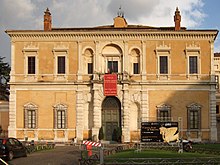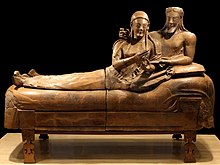Villa Giulia (Rome)
The Villa Giulia is a former papal summer residence in the north of Rome , which today houses the Museo Nazionale Etrusco di Villa Giulia (Etruscan National Museum in the Villa Giulia).
Location and architecture
Villa Giulia is located in an area of Rome known as Vigna Vecchia, which used to be adjacent to the city walls, an area that sits on the slope of Monte Parioli facing the Tiber near Villa Borghese . Today's villa is only a small part of the previous property, which was ultimately made up of three building complexes. Here Pope Julius III. build a summer residence or a villa suburbana .
Like all country houses, Villa Giulia had access to the city (on the Roman road Via Flaminia ) and a garden behind the house. The villa itself was on the cusp of the urban and rural world, an essentially Roman conception that later became commonplace in Western Europe. The casino (small house) was built between 1551 and 1553 according to plans by Giacomo Barozzi da Vignola . Also Bartolomeo Ammannati , Giorgio Vasari and Michelangelo worked here. The Pope invested large sums of money in furnishing the villa, which is one of the best examples of Mannerist architecture.
Vignola's urban front of the building has an ocher yellow two-story facade. The decor shows rustic elements on the ground floor and more delicate forms on the upper floor. In the middle of the facade there is a richly detailed archway, which is continued in its structure on the upper floor, with two window axes to the right and left.
At the rear of the building is Ammanati's large semicircular loggia , which overlooks the first of three courtyards and gives access to the garden and central courtyard. There two marble stairs lead into the heart of the complex, a nymphaeum . Here meals could be taken outside in summer. The structure of the covered loggias on three levels, decorated with marble statues and balustrades, extends around a central fountain, in whose cool and shady environment one could spend the day, protected from the summer heat. This central fountain, the Fontana dell'Acqua Vergine , is a work of art in itself, planned and executed by Vasari and Ammanati, and depicts river gods and caryatids . The Trevi Fountain in Rome is served from the same source of water that feeds this fountain .
The Casino della Vigna (little house in the vineyard), as it used to be called, and its gardens were set in the middle of the vineyards. The participants in the papal celebrations were able to embark at the gates of the Vatican , they were transported up the Tiber to the private dock of the villa, followed by walks in the garden and meals in the nymphaeum.
history
The main building of Villa Giulia was completed in 1553. Pope Julius III At the end of his tenure, he often retired to the property he had built and lived a luxurious lifestyle there. After his death in 1555, his successor Paul IV confiscated the entire property. The villa was divided, the main building and parts of the garden became the property of the Camera Apostolica . Another part of the complex was left to the Pope's nephews from the Borromeo family .
In 1869 a restoration took place on the initiative of Pope Pius IX. In 1870, the property fell in the dissolution of the Papal States to the Kingdom of Italy .
Etruscan Museum
The National Museum of Etruscan Art , the Museo Nazionale Etrusco di Villa Giulia, has been housed in the Villa Giulia since the beginning of the 20th century .
The museum was founded in 1889 with the aim of collecting Roman antiquities from Latium , southern Etruria and Umbria , provided that they are part of the Etruscan culture . Its most famous exhibits are the Apollo von Veji and the almost life-size Sarcofago degli Sposi , a funeral monument made of terracotta on which the bride and groom lean back as if they were at a banquet.
The winner of the Premio Strega , an Italian literary prize, has been decided in the nymphaeum of the villa since 1947 .
Web links
- The Roman villa suburbana and its genesis - In: Arthistoricum.net , accessed on February 14, 2015.
- Museo Nazionale Etrusco di Villa Giulia - side of the Soprintenza per i Beni Archeologici dell'Etruria meridionale
- Villa Giulia
Individual evidence
Coordinates: 41 ° 55 ′ 5.6 " N , 12 ° 28 ′ 40.7" E



